Leadership Analysis: Transactional vs. Transformational at Xerox
VerifiedAdded on 2023/04/06
|11
|3371
|422
Essay
AI Summary
This essay provides an in-depth analysis of the change management program at Xerox, contrasting transactional and transformational leadership styles. It highlights the approaches of leaders like Paul Allaire (transactional) and Anne Mulcahy (transformational), examining how their strategies impacted the company's growth and stability. The essay discusses the implementation of incremental versus radical change, arguing that Xerox utilized both approaches to address its financial challenges and market position. It further elaborates on barriers to change and the framework implemented by CEO Mulcahy to improve Xerox's profitability. The document is available on Desklib, a platform offering study tools and solved assignments for students.
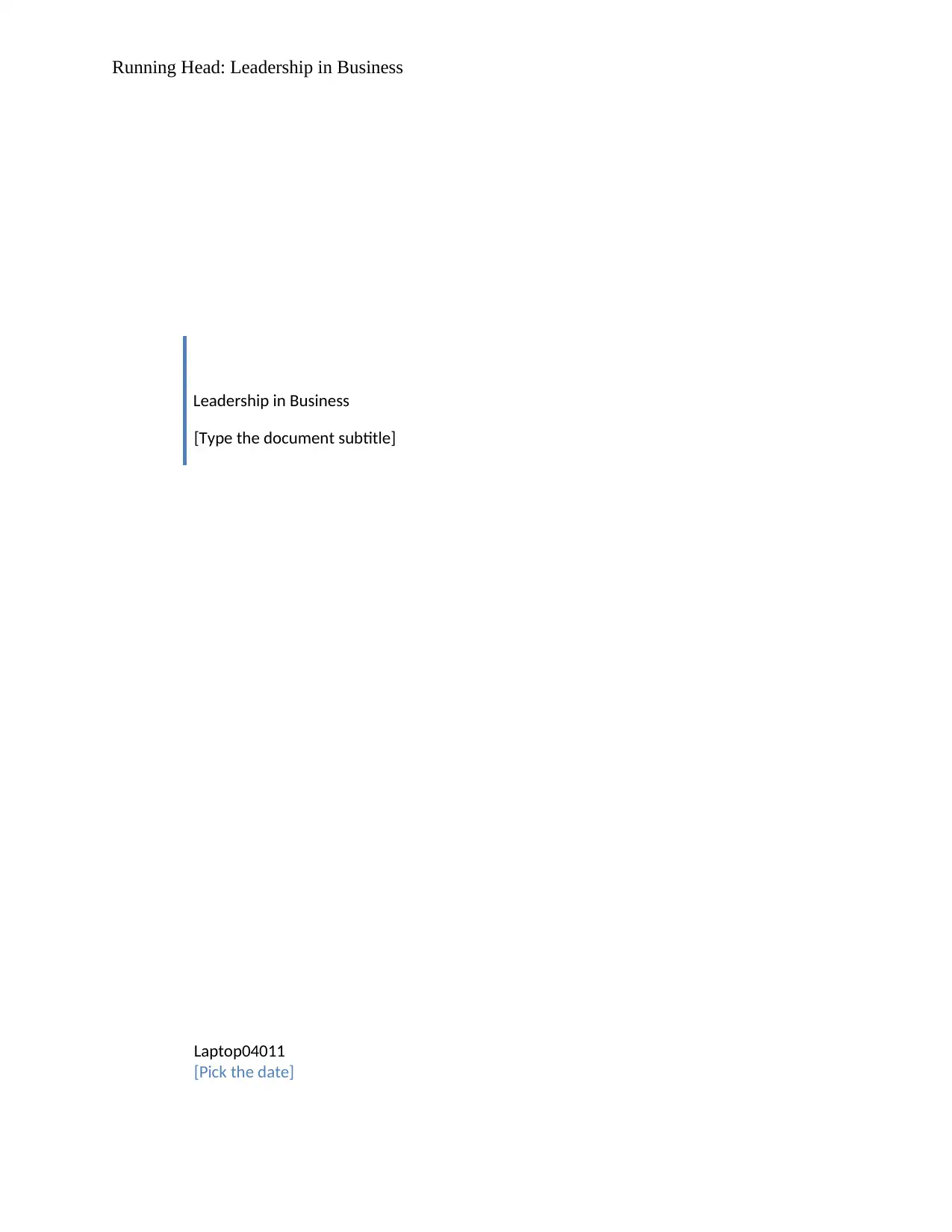
Running Head: Leadership in Business
Leadership in Business
[Type the document subtitle]
Laptop04011
[Pick the date]
Leadership in Business
[Type the document subtitle]
Laptop04011
[Pick the date]
Paraphrase This Document
Need a fresh take? Get an instant paraphrase of this document with our AI Paraphraser
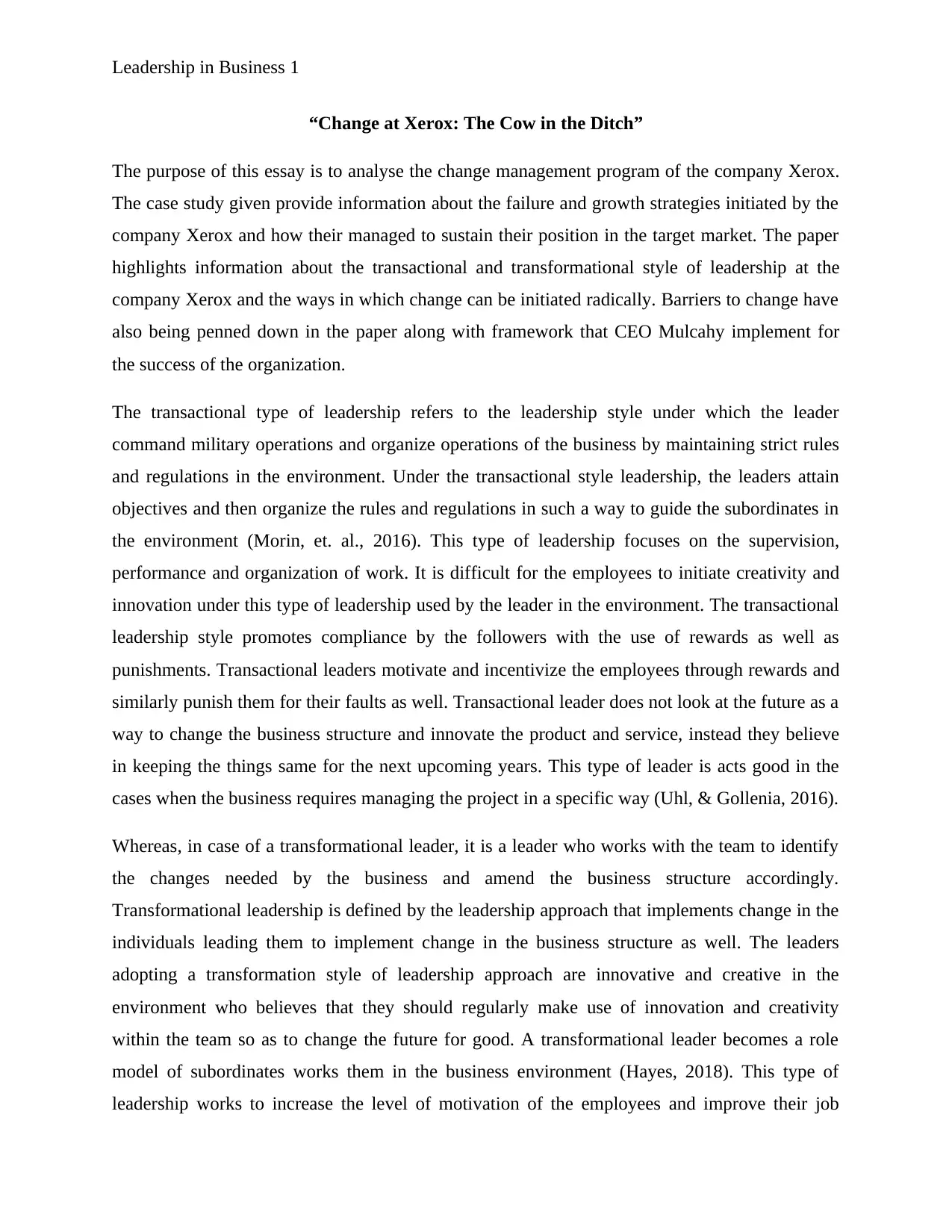
Leadership in Business 1
“Change at Xerox: The Cow in the Ditch”
The purpose of this essay is to analyse the change management program of the company Xerox.
The case study given provide information about the failure and growth strategies initiated by the
company Xerox and how their managed to sustain their position in the target market. The paper
highlights information about the transactional and transformational style of leadership at the
company Xerox and the ways in which change can be initiated radically. Barriers to change have
also being penned down in the paper along with framework that CEO Mulcahy implement for
the success of the organization.
The transactional type of leadership refers to the leadership style under which the leader
command military operations and organize operations of the business by maintaining strict rules
and regulations in the environment. Under the transactional style leadership, the leaders attain
objectives and then organize the rules and regulations in such a way to guide the subordinates in
the environment (Morin, et. al., 2016). This type of leadership focuses on the supervision,
performance and organization of work. It is difficult for the employees to initiate creativity and
innovation under this type of leadership used by the leader in the environment. The transactional
leadership style promotes compliance by the followers with the use of rewards as well as
punishments. Transactional leaders motivate and incentivize the employees through rewards and
similarly punish them for their faults as well. Transactional leader does not look at the future as a
way to change the business structure and innovate the product and service, instead they believe
in keeping the things same for the next upcoming years. This type of leader is acts good in the
cases when the business requires managing the project in a specific way (Uhl, & Gollenia, 2016).
Whereas, in case of a transformational leader, it is a leader who works with the team to identify
the changes needed by the business and amend the business structure accordingly.
Transformational leadership is defined by the leadership approach that implements change in the
individuals leading them to implement change in the business structure as well. The leaders
adopting a transformation style of leadership approach are innovative and creative in the
environment who believes that they should regularly make use of innovation and creativity
within the team so as to change the future for good. A transformational leader becomes a role
model of subordinates works them in the business environment (Hayes, 2018). This type of
leadership works to increase the level of motivation of the employees and improve their job
“Change at Xerox: The Cow in the Ditch”
The purpose of this essay is to analyse the change management program of the company Xerox.
The case study given provide information about the failure and growth strategies initiated by the
company Xerox and how their managed to sustain their position in the target market. The paper
highlights information about the transactional and transformational style of leadership at the
company Xerox and the ways in which change can be initiated radically. Barriers to change have
also being penned down in the paper along with framework that CEO Mulcahy implement for
the success of the organization.
The transactional type of leadership refers to the leadership style under which the leader
command military operations and organize operations of the business by maintaining strict rules
and regulations in the environment. Under the transactional style leadership, the leaders attain
objectives and then organize the rules and regulations in such a way to guide the subordinates in
the environment (Morin, et. al., 2016). This type of leadership focuses on the supervision,
performance and organization of work. It is difficult for the employees to initiate creativity and
innovation under this type of leadership used by the leader in the environment. The transactional
leadership style promotes compliance by the followers with the use of rewards as well as
punishments. Transactional leaders motivate and incentivize the employees through rewards and
similarly punish them for their faults as well. Transactional leader does not look at the future as a
way to change the business structure and innovate the product and service, instead they believe
in keeping the things same for the next upcoming years. This type of leader is acts good in the
cases when the business requires managing the project in a specific way (Uhl, & Gollenia, 2016).
Whereas, in case of a transformational leader, it is a leader who works with the team to identify
the changes needed by the business and amend the business structure accordingly.
Transformational leadership is defined by the leadership approach that implements change in the
individuals leading them to implement change in the business structure as well. The leaders
adopting a transformation style of leadership approach are innovative and creative in the
environment who believes that they should regularly make use of innovation and creativity
within the team so as to change the future for good. A transformational leader becomes a role
model of subordinates works them in the business environment (Hayes, 2018). This type of
leadership works to increase the level of motivation of the employees and improve their job
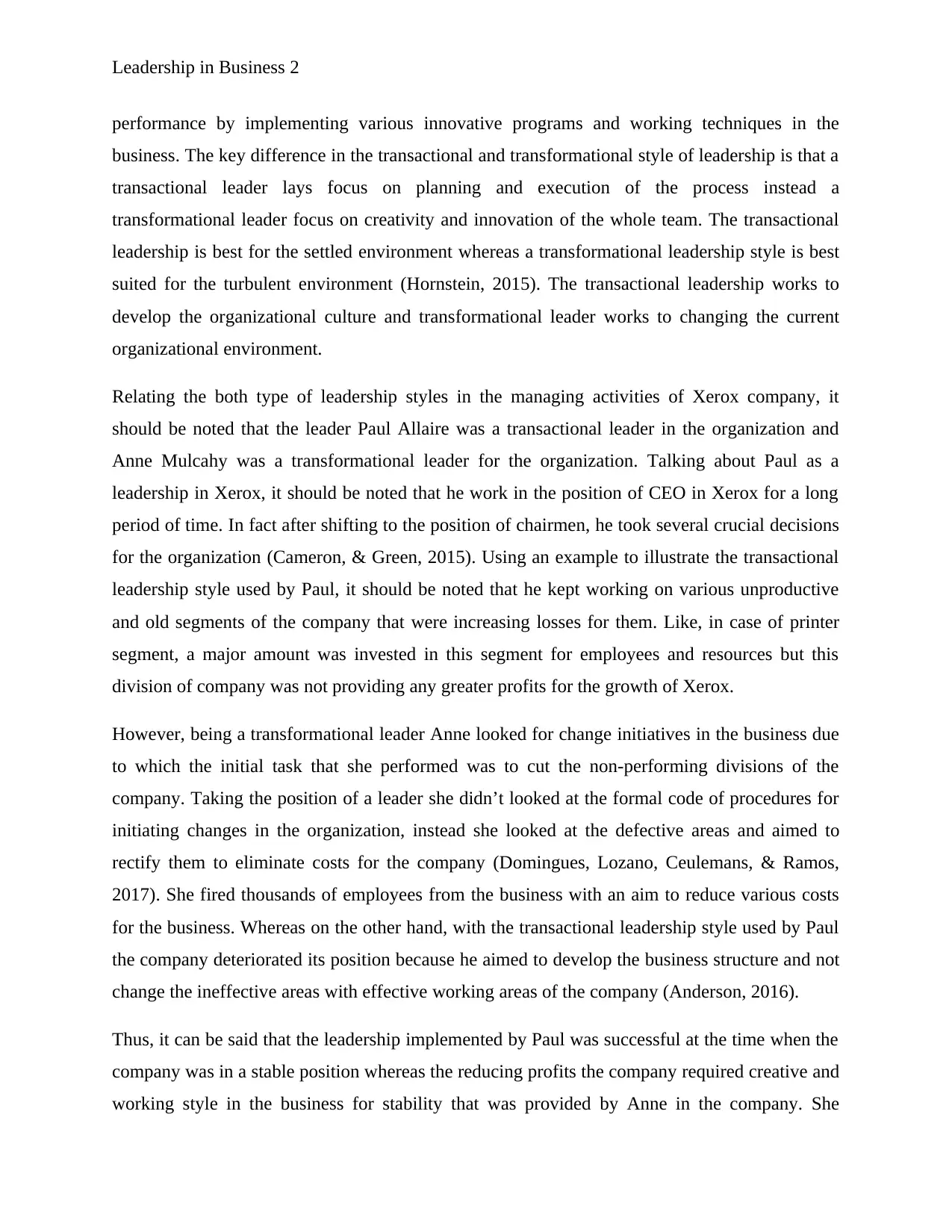
Leadership in Business 2
performance by implementing various innovative programs and working techniques in the
business. The key difference in the transactional and transformational style of leadership is that a
transactional leader lays focus on planning and execution of the process instead a
transformational leader focus on creativity and innovation of the whole team. The transactional
leadership is best for the settled environment whereas a transformational leadership style is best
suited for the turbulent environment (Hornstein, 2015). The transactional leadership works to
develop the organizational culture and transformational leader works to changing the current
organizational environment.
Relating the both type of leadership styles in the managing activities of Xerox company, it
should be noted that the leader Paul Allaire was a transactional leader in the organization and
Anne Mulcahy was a transformational leader for the organization. Talking about Paul as a
leadership in Xerox, it should be noted that he work in the position of CEO in Xerox for a long
period of time. In fact after shifting to the position of chairmen, he took several crucial decisions
for the organization (Cameron, & Green, 2015). Using an example to illustrate the transactional
leadership style used by Paul, it should be noted that he kept working on various unproductive
and old segments of the company that were increasing losses for them. Like, in case of printer
segment, a major amount was invested in this segment for employees and resources but this
division of company was not providing any greater profits for the growth of Xerox.
However, being a transformational leader Anne looked for change initiatives in the business due
to which the initial task that she performed was to cut the non-performing divisions of the
company. Taking the position of a leader she didn’t looked at the formal code of procedures for
initiating changes in the organization, instead she looked at the defective areas and aimed to
rectify them to eliminate costs for the company (Domingues, Lozano, Ceulemans, & Ramos,
2017). She fired thousands of employees from the business with an aim to reduce various costs
for the business. Whereas on the other hand, with the transactional leadership style used by Paul
the company deteriorated its position because he aimed to develop the business structure and not
change the ineffective areas with effective working areas of the company (Anderson, 2016).
Thus, it can be said that the leadership implemented by Paul was successful at the time when the
company was in a stable position whereas the reducing profits the company required creative and
working style in the business for stability that was provided by Anne in the company. She
performance by implementing various innovative programs and working techniques in the
business. The key difference in the transactional and transformational style of leadership is that a
transactional leader lays focus on planning and execution of the process instead a
transformational leader focus on creativity and innovation of the whole team. The transactional
leadership is best for the settled environment whereas a transformational leadership style is best
suited for the turbulent environment (Hornstein, 2015). The transactional leadership works to
develop the organizational culture and transformational leader works to changing the current
organizational environment.
Relating the both type of leadership styles in the managing activities of Xerox company, it
should be noted that the leader Paul Allaire was a transactional leader in the organization and
Anne Mulcahy was a transformational leader for the organization. Talking about Paul as a
leadership in Xerox, it should be noted that he work in the position of CEO in Xerox for a long
period of time. In fact after shifting to the position of chairmen, he took several crucial decisions
for the organization (Cameron, & Green, 2015). Using an example to illustrate the transactional
leadership style used by Paul, it should be noted that he kept working on various unproductive
and old segments of the company that were increasing losses for them. Like, in case of printer
segment, a major amount was invested in this segment for employees and resources but this
division of company was not providing any greater profits for the growth of Xerox.
However, being a transformational leader Anne looked for change initiatives in the business due
to which the initial task that she performed was to cut the non-performing divisions of the
company. Taking the position of a leader she didn’t looked at the formal code of procedures for
initiating changes in the organization, instead she looked at the defective areas and aimed to
rectify them to eliminate costs for the company (Domingues, Lozano, Ceulemans, & Ramos,
2017). She fired thousands of employees from the business with an aim to reduce various costs
for the business. Whereas on the other hand, with the transactional leadership style used by Paul
the company deteriorated its position because he aimed to develop the business structure and not
change the ineffective areas with effective working areas of the company (Anderson, 2016).
Thus, it can be said that the leadership implemented by Paul was successful at the time when the
company was in a stable position whereas the reducing profits the company required creative and
working style in the business for stability that was provided by Anne in the company. She
⊘ This is a preview!⊘
Do you want full access?
Subscribe today to unlock all pages.

Trusted by 1+ million students worldwide
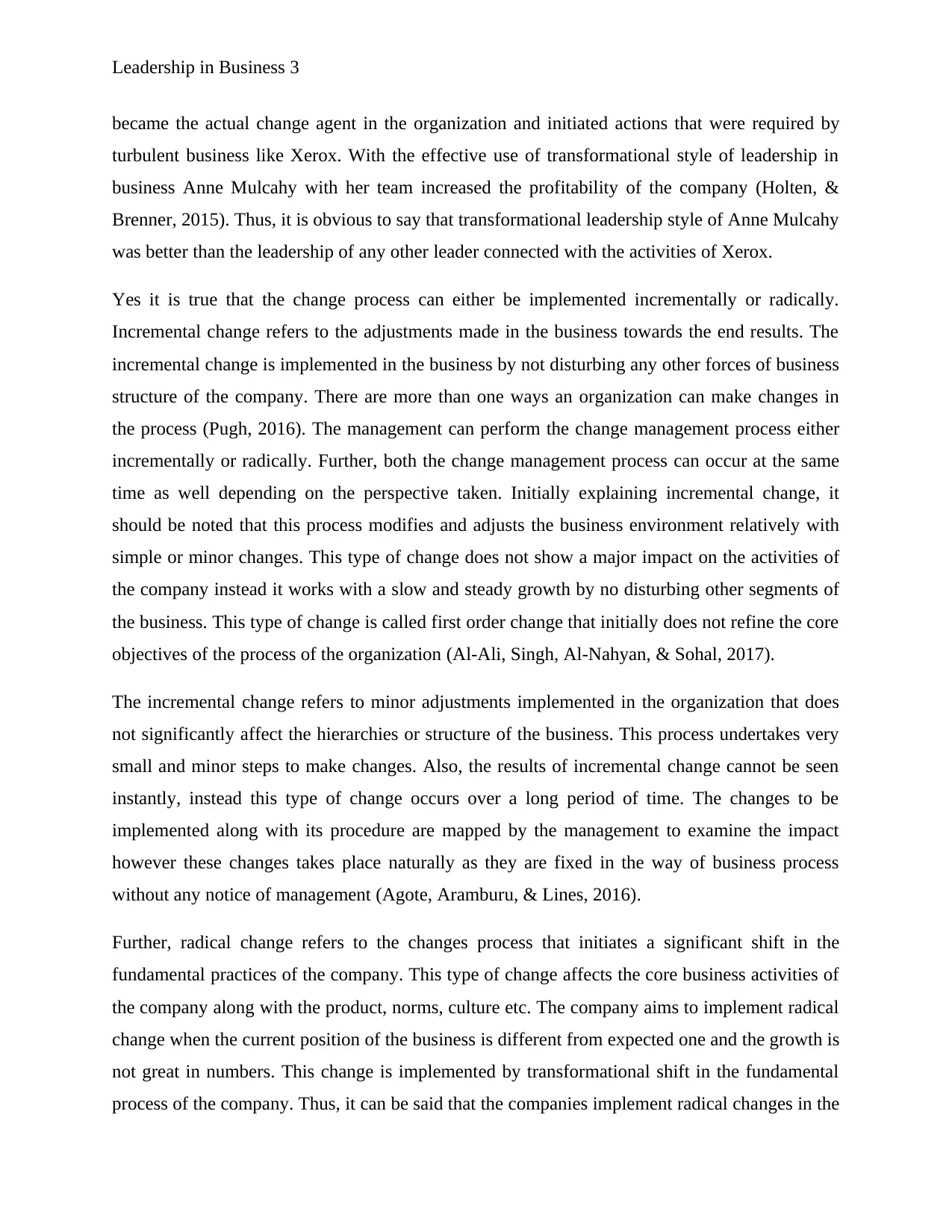
Leadership in Business 3
became the actual change agent in the organization and initiated actions that were required by
turbulent business like Xerox. With the effective use of transformational style of leadership in
business Anne Mulcahy with her team increased the profitability of the company (Holten, &
Brenner, 2015). Thus, it is obvious to say that transformational leadership style of Anne Mulcahy
was better than the leadership of any other leader connected with the activities of Xerox.
Yes it is true that the change process can either be implemented incrementally or radically.
Incremental change refers to the adjustments made in the business towards the end results. The
incremental change is implemented in the business by not disturbing any other forces of business
structure of the company. There are more than one ways an organization can make changes in
the process (Pugh, 2016). The management can perform the change management process either
incrementally or radically. Further, both the change management process can occur at the same
time as well depending on the perspective taken. Initially explaining incremental change, it
should be noted that this process modifies and adjusts the business environment relatively with
simple or minor changes. This type of change does not show a major impact on the activities of
the company instead it works with a slow and steady growth by no disturbing other segments of
the business. This type of change is called first order change that initially does not refine the core
objectives of the process of the organization (Al-Ali, Singh, Al-Nahyan, & Sohal, 2017).
The incremental change refers to minor adjustments implemented in the organization that does
not significantly affect the hierarchies or structure of the business. This process undertakes very
small and minor steps to make changes. Also, the results of incremental change cannot be seen
instantly, instead this type of change occurs over a long period of time. The changes to be
implemented along with its procedure are mapped by the management to examine the impact
however these changes takes place naturally as they are fixed in the way of business process
without any notice of management (Agote, Aramburu, & Lines, 2016).
Further, radical change refers to the changes process that initiates a significant shift in the
fundamental practices of the company. This type of change affects the core business activities of
the company along with the product, norms, culture etc. The company aims to implement radical
change when the current position of the business is different from expected one and the growth is
not great in numbers. This change is implemented by transformational shift in the fundamental
process of the company. Thus, it can be said that the companies implement radical changes in the
became the actual change agent in the organization and initiated actions that were required by
turbulent business like Xerox. With the effective use of transformational style of leadership in
business Anne Mulcahy with her team increased the profitability of the company (Holten, &
Brenner, 2015). Thus, it is obvious to say that transformational leadership style of Anne Mulcahy
was better than the leadership of any other leader connected with the activities of Xerox.
Yes it is true that the change process can either be implemented incrementally or radically.
Incremental change refers to the adjustments made in the business towards the end results. The
incremental change is implemented in the business by not disturbing any other forces of business
structure of the company. There are more than one ways an organization can make changes in
the process (Pugh, 2016). The management can perform the change management process either
incrementally or radically. Further, both the change management process can occur at the same
time as well depending on the perspective taken. Initially explaining incremental change, it
should be noted that this process modifies and adjusts the business environment relatively with
simple or minor changes. This type of change does not show a major impact on the activities of
the company instead it works with a slow and steady growth by no disturbing other segments of
the business. This type of change is called first order change that initially does not refine the core
objectives of the process of the organization (Al-Ali, Singh, Al-Nahyan, & Sohal, 2017).
The incremental change refers to minor adjustments implemented in the organization that does
not significantly affect the hierarchies or structure of the business. This process undertakes very
small and minor steps to make changes. Also, the results of incremental change cannot be seen
instantly, instead this type of change occurs over a long period of time. The changes to be
implemented along with its procedure are mapped by the management to examine the impact
however these changes takes place naturally as they are fixed in the way of business process
without any notice of management (Agote, Aramburu, & Lines, 2016).
Further, radical change refers to the changes process that initiates a significant shift in the
fundamental practices of the company. This type of change affects the core business activities of
the company along with the product, norms, culture etc. The company aims to implement radical
change when the current position of the business is different from expected one and the growth is
not great in numbers. This change is implemented by transformational shift in the fundamental
process of the company. Thus, it can be said that the companies implement radical changes in the
Paraphrase This Document
Need a fresh take? Get an instant paraphrase of this document with our AI Paraphraser
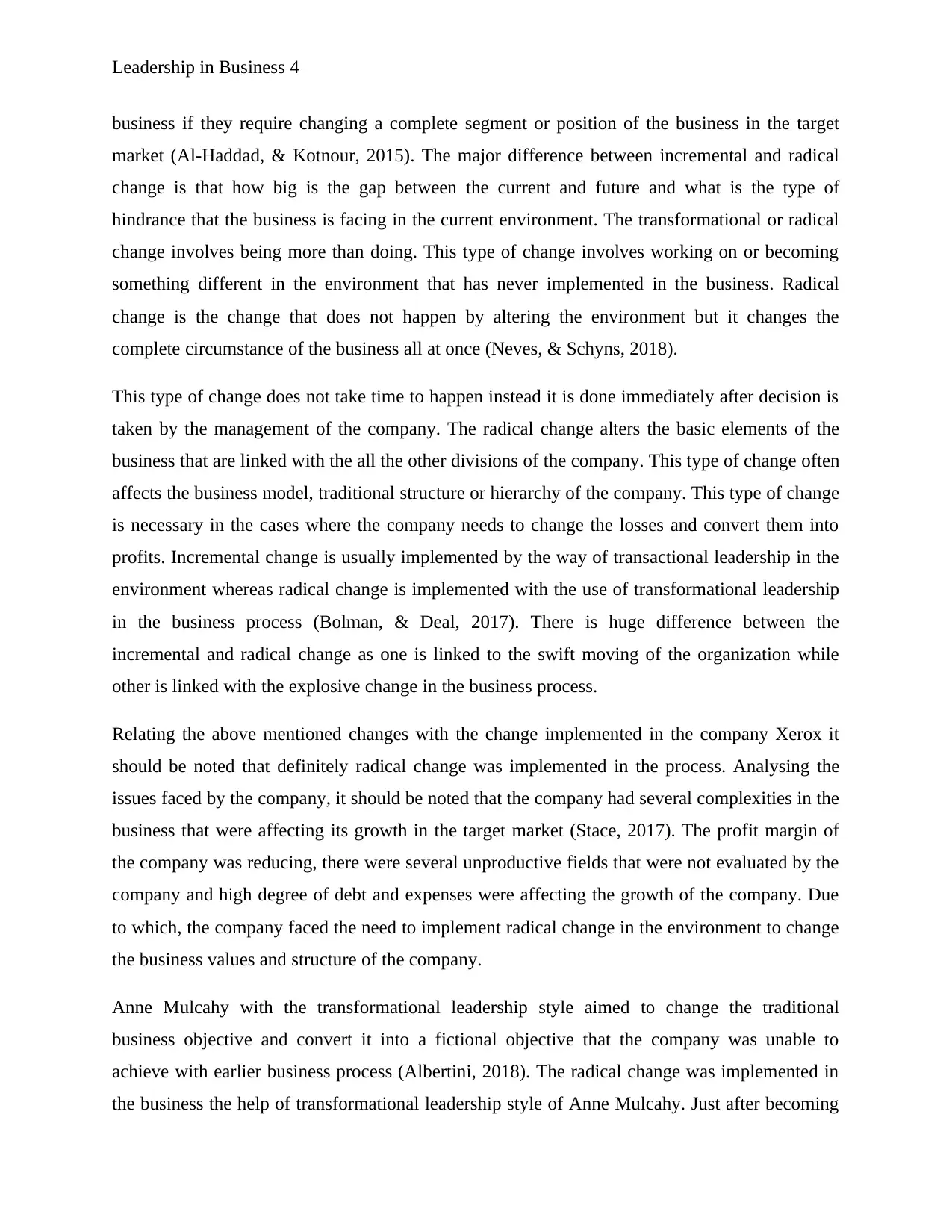
Leadership in Business 4
business if they require changing a complete segment or position of the business in the target
market (Al-Haddad, & Kotnour, 2015). The major difference between incremental and radical
change is that how big is the gap between the current and future and what is the type of
hindrance that the business is facing in the current environment. The transformational or radical
change involves being more than doing. This type of change involves working on or becoming
something different in the environment that has never implemented in the business. Radical
change is the change that does not happen by altering the environment but it changes the
complete circumstance of the business all at once (Neves, & Schyns, 2018).
This type of change does not take time to happen instead it is done immediately after decision is
taken by the management of the company. The radical change alters the basic elements of the
business that are linked with the all the other divisions of the company. This type of change often
affects the business model, traditional structure or hierarchy of the company. This type of change
is necessary in the cases where the company needs to change the losses and convert them into
profits. Incremental change is usually implemented by the way of transactional leadership in the
environment whereas radical change is implemented with the use of transformational leadership
in the business process (Bolman, & Deal, 2017). There is huge difference between the
incremental and radical change as one is linked to the swift moving of the organization while
other is linked with the explosive change in the business process.
Relating the above mentioned changes with the change implemented in the company Xerox it
should be noted that definitely radical change was implemented in the process. Analysing the
issues faced by the company, it should be noted that the company had several complexities in the
business that were affecting its growth in the target market (Stace, 2017). The profit margin of
the company was reducing, there were several unproductive fields that were not evaluated by the
company and high degree of debt and expenses were affecting the growth of the company. Due
to which, the company faced the need to implement radical change in the environment to change
the business values and structure of the company.
Anne Mulcahy with the transformational leadership style aimed to change the traditional
business objective and convert it into a fictional objective that the company was unable to
achieve with earlier business process (Albertini, 2018). The radical change was implemented in
the business the help of transformational leadership style of Anne Mulcahy. Just after becoming
business if they require changing a complete segment or position of the business in the target
market (Al-Haddad, & Kotnour, 2015). The major difference between incremental and radical
change is that how big is the gap between the current and future and what is the type of
hindrance that the business is facing in the current environment. The transformational or radical
change involves being more than doing. This type of change involves working on or becoming
something different in the environment that has never implemented in the business. Radical
change is the change that does not happen by altering the environment but it changes the
complete circumstance of the business all at once (Neves, & Schyns, 2018).
This type of change does not take time to happen instead it is done immediately after decision is
taken by the management of the company. The radical change alters the basic elements of the
business that are linked with the all the other divisions of the company. This type of change often
affects the business model, traditional structure or hierarchy of the company. This type of change
is necessary in the cases where the company needs to change the losses and convert them into
profits. Incremental change is usually implemented by the way of transactional leadership in the
environment whereas radical change is implemented with the use of transformational leadership
in the business process (Bolman, & Deal, 2017). There is huge difference between the
incremental and radical change as one is linked to the swift moving of the organization while
other is linked with the explosive change in the business process.
Relating the above mentioned changes with the change implemented in the company Xerox it
should be noted that definitely radical change was implemented in the process. Analysing the
issues faced by the company, it should be noted that the company had several complexities in the
business that were affecting its growth in the target market (Stace, 2017). The profit margin of
the company was reducing, there were several unproductive fields that were not evaluated by the
company and high degree of debt and expenses were affecting the growth of the company. Due
to which, the company faced the need to implement radical change in the environment to change
the business values and structure of the company.
Anne Mulcahy with the transformational leadership style aimed to change the traditional
business objective and convert it into a fictional objective that the company was unable to
achieve with earlier business process (Albertini, 2018). The radical change was implemented in
the business the help of transformational leadership style of Anne Mulcahy. Just after becoming
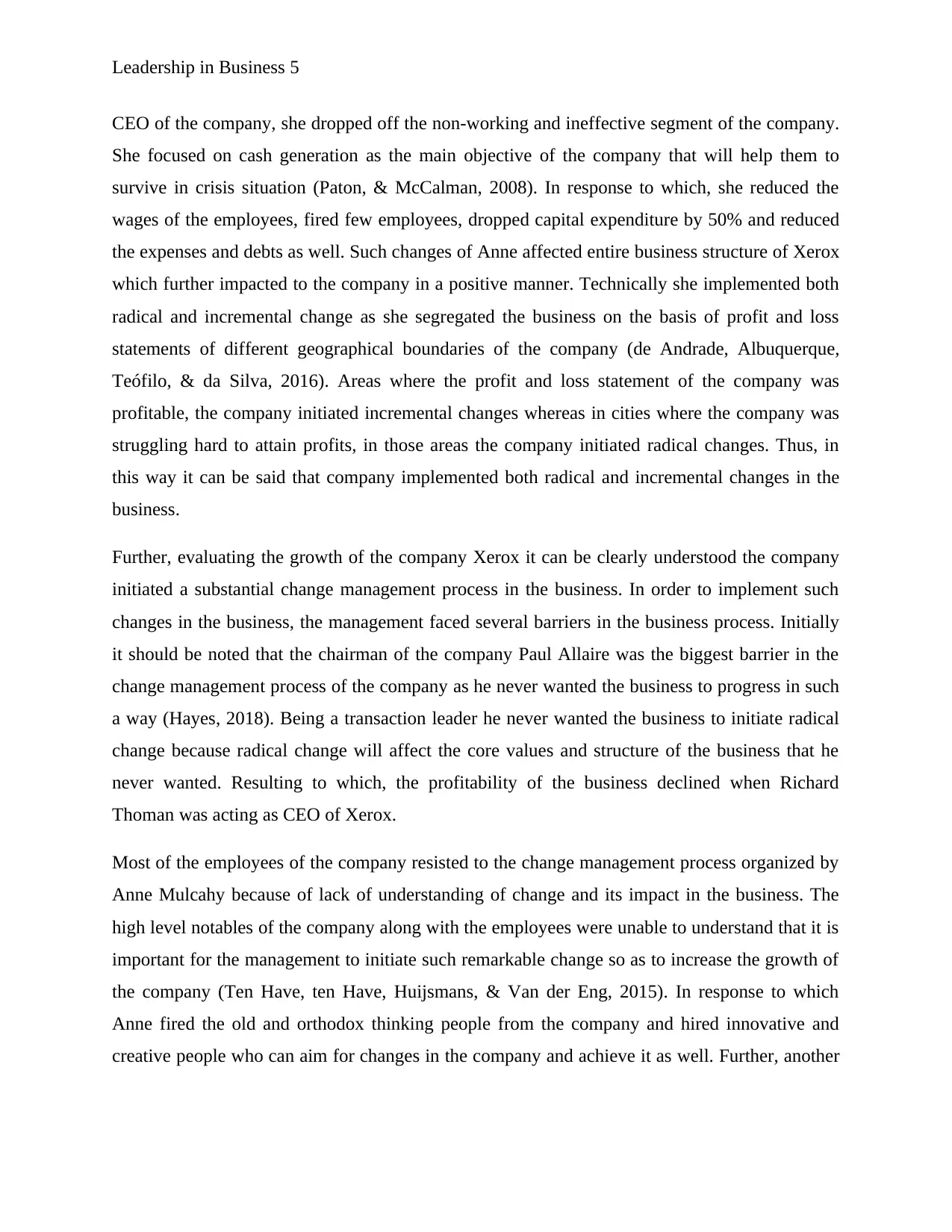
Leadership in Business 5
CEO of the company, she dropped off the non-working and ineffective segment of the company.
She focused on cash generation as the main objective of the company that will help them to
survive in crisis situation (Paton, & McCalman, 2008). In response to which, she reduced the
wages of the employees, fired few employees, dropped capital expenditure by 50% and reduced
the expenses and debts as well. Such changes of Anne affected entire business structure of Xerox
which further impacted to the company in a positive manner. Technically she implemented both
radical and incremental change as she segregated the business on the basis of profit and loss
statements of different geographical boundaries of the company (de Andrade, Albuquerque,
Teófilo, & da Silva, 2016). Areas where the profit and loss statement of the company was
profitable, the company initiated incremental changes whereas in cities where the company was
struggling hard to attain profits, in those areas the company initiated radical changes. Thus, in
this way it can be said that company implemented both radical and incremental changes in the
business.
Further, evaluating the growth of the company Xerox it can be clearly understood the company
initiated a substantial change management process in the business. In order to implement such
changes in the business, the management faced several barriers in the business process. Initially
it should be noted that the chairman of the company Paul Allaire was the biggest barrier in the
change management process of the company as he never wanted the business to progress in such
a way (Hayes, 2018). Being a transaction leader he never wanted the business to initiate radical
change because radical change will affect the core values and structure of the business that he
never wanted. Resulting to which, the profitability of the business declined when Richard
Thoman was acting as CEO of Xerox.
Most of the employees of the company resisted to the change management process organized by
Anne Mulcahy because of lack of understanding of change and its impact in the business. The
high level notables of the company along with the employees were unable to understand that it is
important for the management to initiate such remarkable change so as to increase the growth of
the company (Ten Have, ten Have, Huijsmans, & Van der Eng, 2015). In response to which
Anne fired the old and orthodox thinking people from the company and hired innovative and
creative people who can aim for changes in the company and achieve it as well. Further, another
CEO of the company, she dropped off the non-working and ineffective segment of the company.
She focused on cash generation as the main objective of the company that will help them to
survive in crisis situation (Paton, & McCalman, 2008). In response to which, she reduced the
wages of the employees, fired few employees, dropped capital expenditure by 50% and reduced
the expenses and debts as well. Such changes of Anne affected entire business structure of Xerox
which further impacted to the company in a positive manner. Technically she implemented both
radical and incremental change as she segregated the business on the basis of profit and loss
statements of different geographical boundaries of the company (de Andrade, Albuquerque,
Teófilo, & da Silva, 2016). Areas where the profit and loss statement of the company was
profitable, the company initiated incremental changes whereas in cities where the company was
struggling hard to attain profits, in those areas the company initiated radical changes. Thus, in
this way it can be said that company implemented both radical and incremental changes in the
business.
Further, evaluating the growth of the company Xerox it can be clearly understood the company
initiated a substantial change management process in the business. In order to implement such
changes in the business, the management faced several barriers in the business process. Initially
it should be noted that the chairman of the company Paul Allaire was the biggest barrier in the
change management process of the company as he never wanted the business to progress in such
a way (Hayes, 2018). Being a transaction leader he never wanted the business to initiate radical
change because radical change will affect the core values and structure of the business that he
never wanted. Resulting to which, the profitability of the business declined when Richard
Thoman was acting as CEO of Xerox.
Most of the employees of the company resisted to the change management process organized by
Anne Mulcahy because of lack of understanding of change and its impact in the business. The
high level notables of the company along with the employees were unable to understand that it is
important for the management to initiate such remarkable change so as to increase the growth of
the company (Ten Have, ten Have, Huijsmans, & Van der Eng, 2015). In response to which
Anne fired the old and orthodox thinking people from the company and hired innovative and
creative people who can aim for changes in the company and achieve it as well. Further, another
⊘ This is a preview!⊘
Do you want full access?
Subscribe today to unlock all pages.

Trusted by 1+ million students worldwide
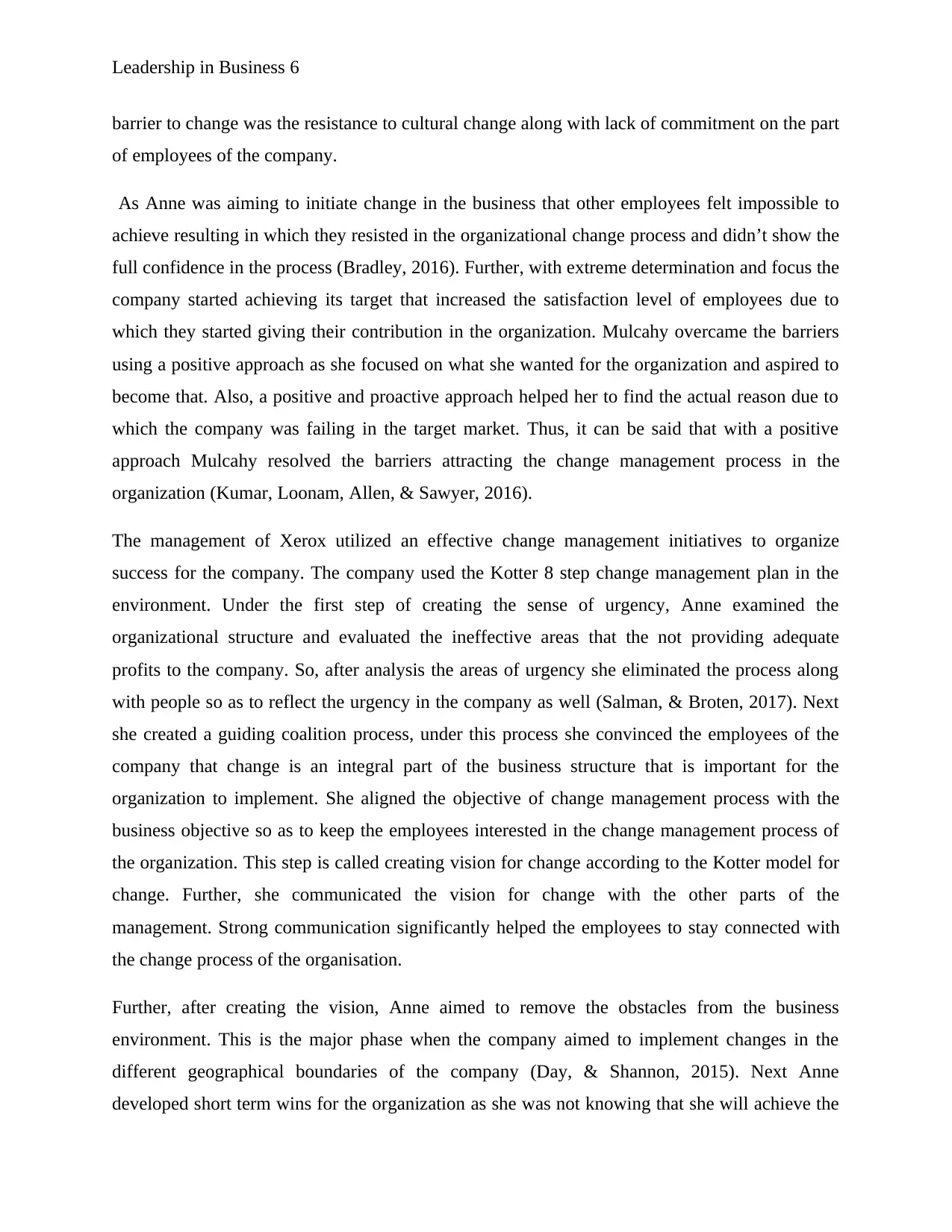
Leadership in Business 6
barrier to change was the resistance to cultural change along with lack of commitment on the part
of employees of the company.
As Anne was aiming to initiate change in the business that other employees felt impossible to
achieve resulting in which they resisted in the organizational change process and didn’t show the
full confidence in the process (Bradley, 2016). Further, with extreme determination and focus the
company started achieving its target that increased the satisfaction level of employees due to
which they started giving their contribution in the organization. Mulcahy overcame the barriers
using a positive approach as she focused on what she wanted for the organization and aspired to
become that. Also, a positive and proactive approach helped her to find the actual reason due to
which the company was failing in the target market. Thus, it can be said that with a positive
approach Mulcahy resolved the barriers attracting the change management process in the
organization (Kumar, Loonam, Allen, & Sawyer, 2016).
The management of Xerox utilized an effective change management initiatives to organize
success for the company. The company used the Kotter 8 step change management plan in the
environment. Under the first step of creating the sense of urgency, Anne examined the
organizational structure and evaluated the ineffective areas that the not providing adequate
profits to the company. So, after analysis the areas of urgency she eliminated the process along
with people so as to reflect the urgency in the company as well (Salman, & Broten, 2017). Next
she created a guiding coalition process, under this process she convinced the employees of the
company that change is an integral part of the business structure that is important for the
organization to implement. She aligned the objective of change management process with the
business objective so as to keep the employees interested in the change management process of
the organization. This step is called creating vision for change according to the Kotter model for
change. Further, she communicated the vision for change with the other parts of the
management. Strong communication significantly helped the employees to stay connected with
the change process of the organisation.
Further, after creating the vision, Anne aimed to remove the obstacles from the business
environment. This is the major phase when the company aimed to implement changes in the
different geographical boundaries of the company (Day, & Shannon, 2015). Next Anne
developed short term wins for the organization as she was not knowing that she will achieve the
barrier to change was the resistance to cultural change along with lack of commitment on the part
of employees of the company.
As Anne was aiming to initiate change in the business that other employees felt impossible to
achieve resulting in which they resisted in the organizational change process and didn’t show the
full confidence in the process (Bradley, 2016). Further, with extreme determination and focus the
company started achieving its target that increased the satisfaction level of employees due to
which they started giving their contribution in the organization. Mulcahy overcame the barriers
using a positive approach as she focused on what she wanted for the organization and aspired to
become that. Also, a positive and proactive approach helped her to find the actual reason due to
which the company was failing in the target market. Thus, it can be said that with a positive
approach Mulcahy resolved the barriers attracting the change management process in the
organization (Kumar, Loonam, Allen, & Sawyer, 2016).
The management of Xerox utilized an effective change management initiatives to organize
success for the company. The company used the Kotter 8 step change management plan in the
environment. Under the first step of creating the sense of urgency, Anne examined the
organizational structure and evaluated the ineffective areas that the not providing adequate
profits to the company. So, after analysis the areas of urgency she eliminated the process along
with people so as to reflect the urgency in the company as well (Salman, & Broten, 2017). Next
she created a guiding coalition process, under this process she convinced the employees of the
company that change is an integral part of the business structure that is important for the
organization to implement. She aligned the objective of change management process with the
business objective so as to keep the employees interested in the change management process of
the organization. This step is called creating vision for change according to the Kotter model for
change. Further, she communicated the vision for change with the other parts of the
management. Strong communication significantly helped the employees to stay connected with
the change process of the organisation.
Further, after creating the vision, Anne aimed to remove the obstacles from the business
environment. This is the major phase when the company aimed to implement changes in the
different geographical boundaries of the company (Day, & Shannon, 2015). Next Anne
developed short term wins for the organization as she was not knowing that she will achieve the
Paraphrase This Document
Need a fresh take? Get an instant paraphrase of this document with our AI Paraphraser
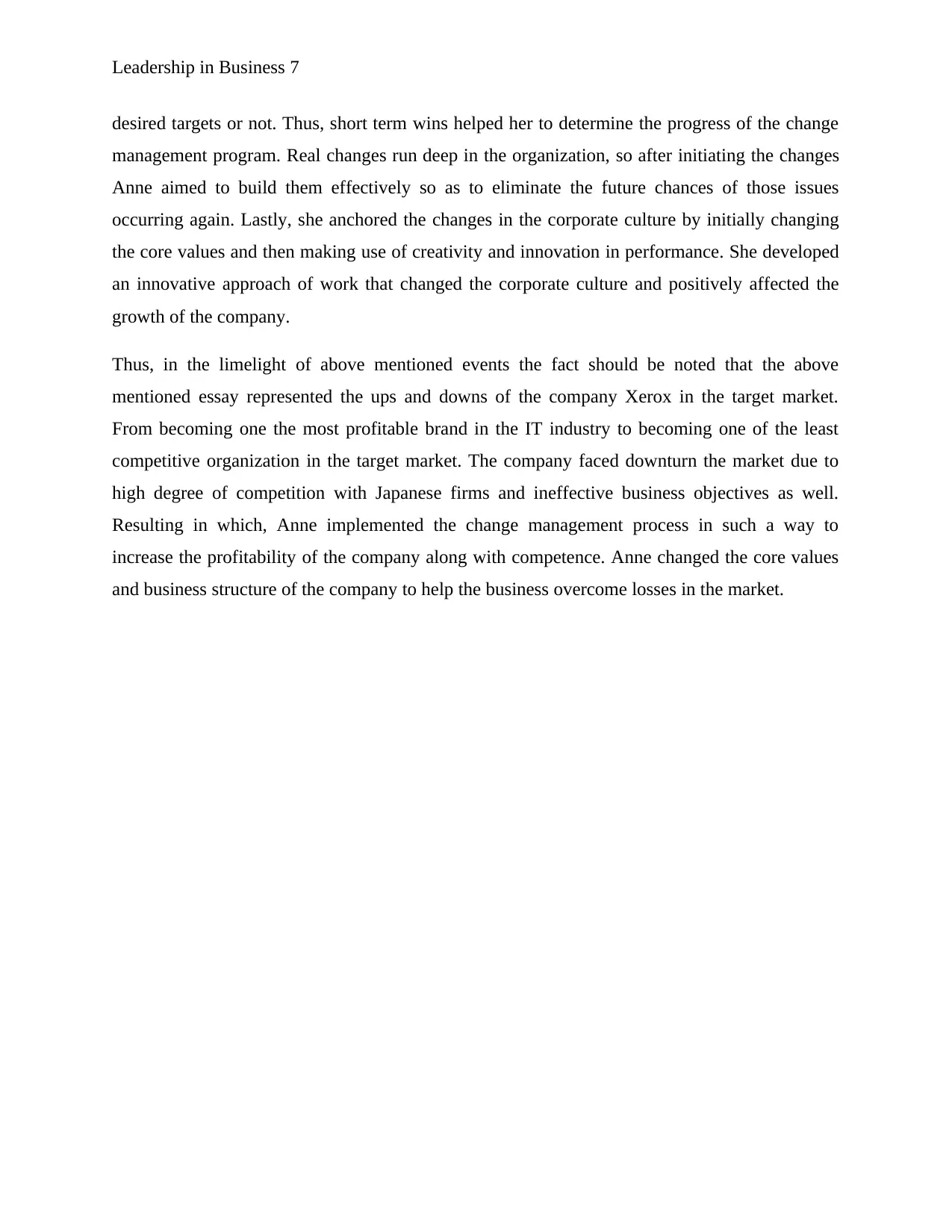
Leadership in Business 7
desired targets or not. Thus, short term wins helped her to determine the progress of the change
management program. Real changes run deep in the organization, so after initiating the changes
Anne aimed to build them effectively so as to eliminate the future chances of those issues
occurring again. Lastly, she anchored the changes in the corporate culture by initially changing
the core values and then making use of creativity and innovation in performance. She developed
an innovative approach of work that changed the corporate culture and positively affected the
growth of the company.
Thus, in the limelight of above mentioned events the fact should be noted that the above
mentioned essay represented the ups and downs of the company Xerox in the target market.
From becoming one the most profitable brand in the IT industry to becoming one of the least
competitive organization in the target market. The company faced downturn the market due to
high degree of competition with Japanese firms and ineffective business objectives as well.
Resulting in which, Anne implemented the change management process in such a way to
increase the profitability of the company along with competence. Anne changed the core values
and business structure of the company to help the business overcome losses in the market.
desired targets or not. Thus, short term wins helped her to determine the progress of the change
management program. Real changes run deep in the organization, so after initiating the changes
Anne aimed to build them effectively so as to eliminate the future chances of those issues
occurring again. Lastly, she anchored the changes in the corporate culture by initially changing
the core values and then making use of creativity and innovation in performance. She developed
an innovative approach of work that changed the corporate culture and positively affected the
growth of the company.
Thus, in the limelight of above mentioned events the fact should be noted that the above
mentioned essay represented the ups and downs of the company Xerox in the target market.
From becoming one the most profitable brand in the IT industry to becoming one of the least
competitive organization in the target market. The company faced downturn the market due to
high degree of competition with Japanese firms and ineffective business objectives as well.
Resulting in which, Anne implemented the change management process in such a way to
increase the profitability of the company along with competence. Anne changed the core values
and business structure of the company to help the business overcome losses in the market.
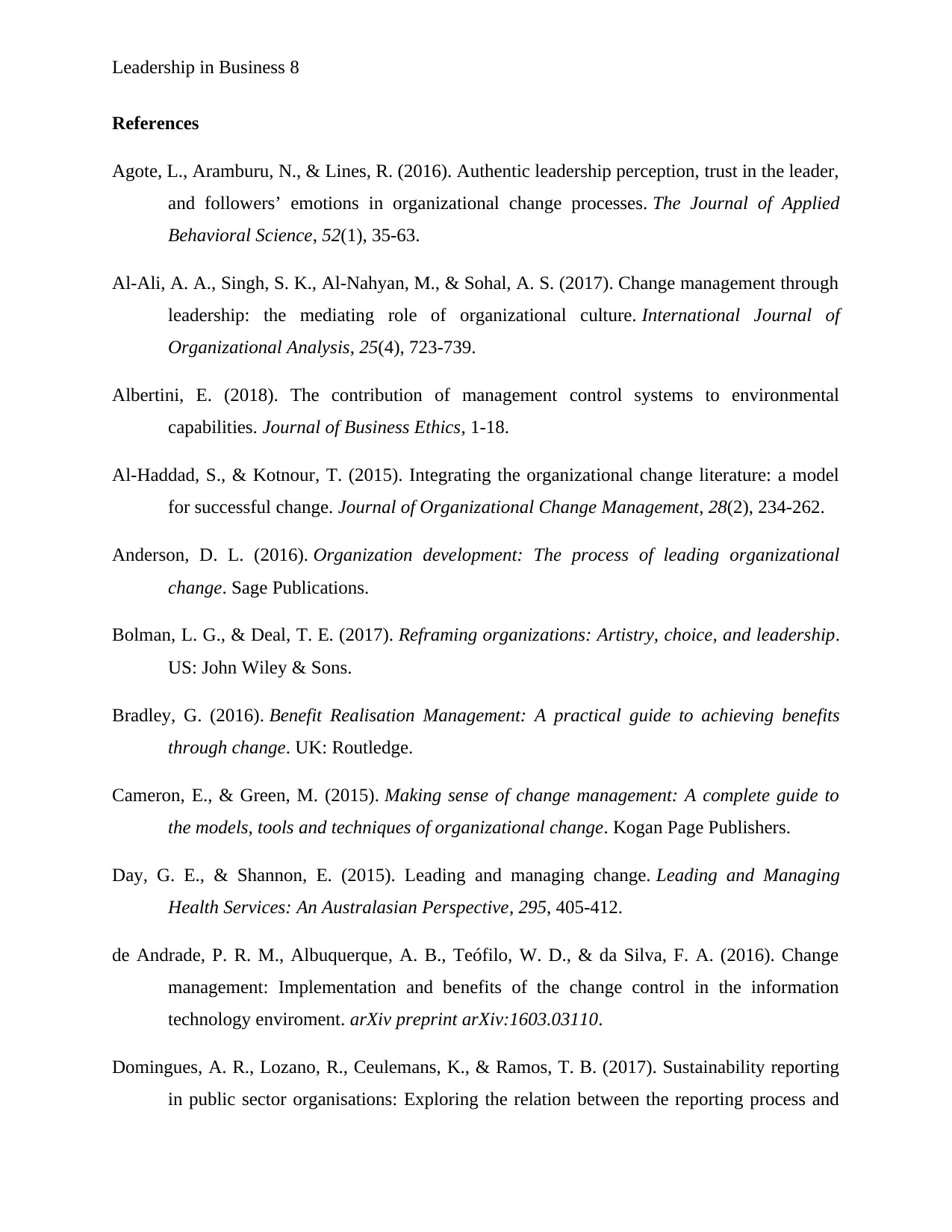
Leadership in Business 8
References
Agote, L., Aramburu, N., & Lines, R. (2016). Authentic leadership perception, trust in the leader,
and followers’ emotions in organizational change processes. The Journal of Applied
Behavioral Science, 52(1), 35-63.
Al-Ali, A. A., Singh, S. K., Al-Nahyan, M., & Sohal, A. S. (2017). Change management through
leadership: the mediating role of organizational culture. International Journal of
Organizational Analysis, 25(4), 723-739.
Albertini, E. (2018). The contribution of management control systems to environmental
capabilities. Journal of Business Ethics, 1-18.
Al-Haddad, S., & Kotnour, T. (2015). Integrating the organizational change literature: a model
for successful change. Journal of Organizational Change Management, 28(2), 234-262.
Anderson, D. L. (2016). Organization development: The process of leading organizational
change. Sage Publications.
Bolman, L. G., & Deal, T. E. (2017). Reframing organizations: Artistry, choice, and leadership.
US: John Wiley & Sons.
Bradley, G. (2016). Benefit Realisation Management: A practical guide to achieving benefits
through change. UK: Routledge.
Cameron, E., & Green, M. (2015). Making sense of change management: A complete guide to
the models, tools and techniques of organizational change. Kogan Page Publishers.
Day, G. E., & Shannon, E. (2015). Leading and managing change. Leading and Managing
Health Services: An Australasian Perspective, 295, 405-412.
de Andrade, P. R. M., Albuquerque, A. B., Teófilo, W. D., & da Silva, F. A. (2016). Change
management: Implementation and benefits of the change control in the information
technology enviroment. arXiv preprint arXiv:1603.03110.
Domingues, A. R., Lozano, R., Ceulemans, K., & Ramos, T. B. (2017). Sustainability reporting
in public sector organisations: Exploring the relation between the reporting process and
References
Agote, L., Aramburu, N., & Lines, R. (2016). Authentic leadership perception, trust in the leader,
and followers’ emotions in organizational change processes. The Journal of Applied
Behavioral Science, 52(1), 35-63.
Al-Ali, A. A., Singh, S. K., Al-Nahyan, M., & Sohal, A. S. (2017). Change management through
leadership: the mediating role of organizational culture. International Journal of
Organizational Analysis, 25(4), 723-739.
Albertini, E. (2018). The contribution of management control systems to environmental
capabilities. Journal of Business Ethics, 1-18.
Al-Haddad, S., & Kotnour, T. (2015). Integrating the organizational change literature: a model
for successful change. Journal of Organizational Change Management, 28(2), 234-262.
Anderson, D. L. (2016). Organization development: The process of leading organizational
change. Sage Publications.
Bolman, L. G., & Deal, T. E. (2017). Reframing organizations: Artistry, choice, and leadership.
US: John Wiley & Sons.
Bradley, G. (2016). Benefit Realisation Management: A practical guide to achieving benefits
through change. UK: Routledge.
Cameron, E., & Green, M. (2015). Making sense of change management: A complete guide to
the models, tools and techniques of organizational change. Kogan Page Publishers.
Day, G. E., & Shannon, E. (2015). Leading and managing change. Leading and Managing
Health Services: An Australasian Perspective, 295, 405-412.
de Andrade, P. R. M., Albuquerque, A. B., Teófilo, W. D., & da Silva, F. A. (2016). Change
management: Implementation and benefits of the change control in the information
technology enviroment. arXiv preprint arXiv:1603.03110.
Domingues, A. R., Lozano, R., Ceulemans, K., & Ramos, T. B. (2017). Sustainability reporting
in public sector organisations: Exploring the relation between the reporting process and
⊘ This is a preview!⊘
Do you want full access?
Subscribe today to unlock all pages.

Trusted by 1+ million students worldwide
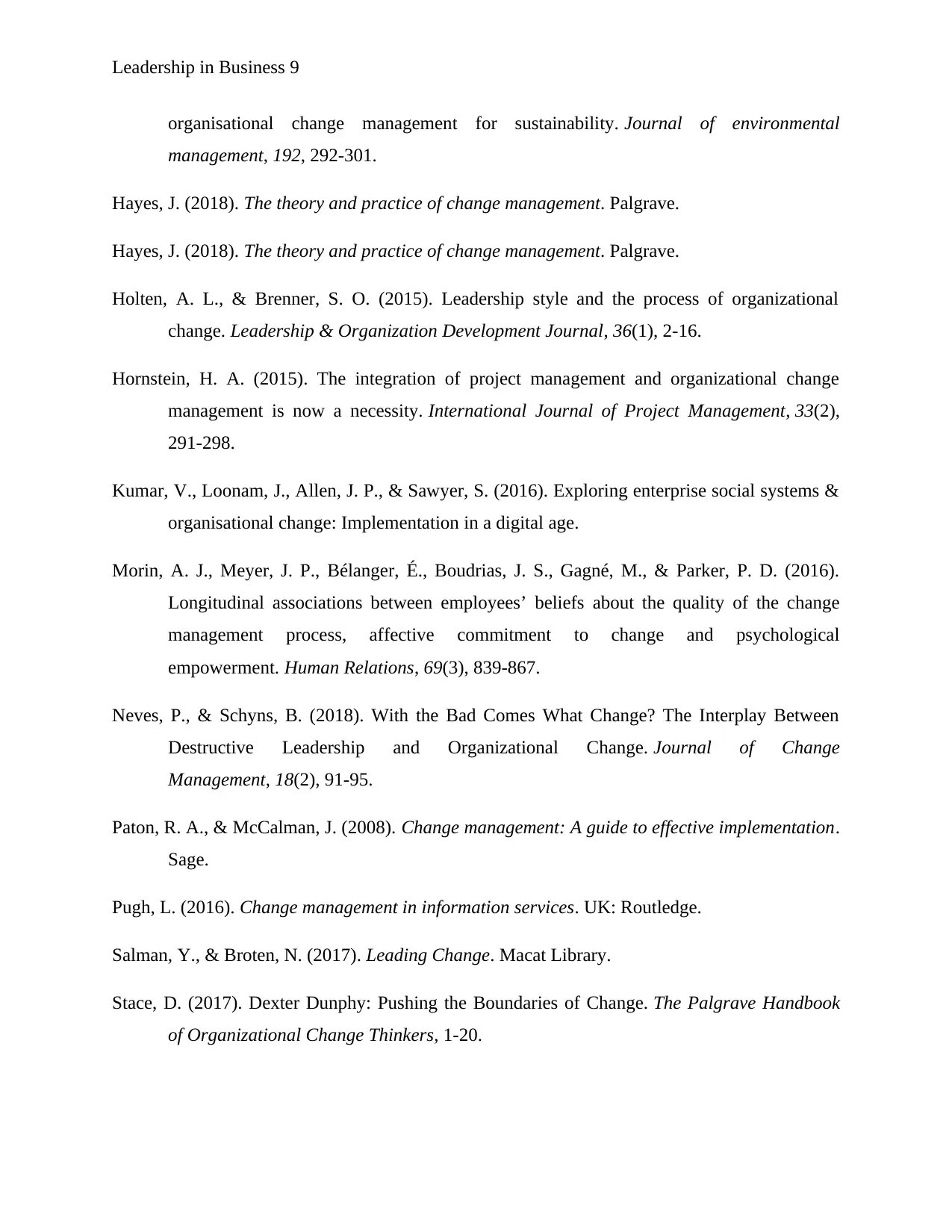
Leadership in Business 9
organisational change management for sustainability. Journal of environmental
management, 192, 292-301.
Hayes, J. (2018). The theory and practice of change management. Palgrave.
Hayes, J. (2018). The theory and practice of change management. Palgrave.
Holten, A. L., & Brenner, S. O. (2015). Leadership style and the process of organizational
change. Leadership & Organization Development Journal, 36(1), 2-16.
Hornstein, H. A. (2015). The integration of project management and organizational change
management is now a necessity. International Journal of Project Management, 33(2),
291-298.
Kumar, V., Loonam, J., Allen, J. P., & Sawyer, S. (2016). Exploring enterprise social systems &
organisational change: Implementation in a digital age.
Morin, A. J., Meyer, J. P., Bélanger, É., Boudrias, J. S., Gagné, M., & Parker, P. D. (2016).
Longitudinal associations between employees’ beliefs about the quality of the change
management process, affective commitment to change and psychological
empowerment. Human Relations, 69(3), 839-867.
Neves, P., & Schyns, B. (2018). With the Bad Comes What Change? The Interplay Between
Destructive Leadership and Organizational Change. Journal of Change
Management, 18(2), 91-95.
Paton, R. A., & McCalman, J. (2008). Change management: A guide to effective implementation.
Sage.
Pugh, L. (2016). Change management in information services. UK: Routledge.
Salman, Y., & Broten, N. (2017). Leading Change. Macat Library.
Stace, D. (2017). Dexter Dunphy: Pushing the Boundaries of Change. The Palgrave Handbook
of Organizational Change Thinkers, 1-20.
organisational change management for sustainability. Journal of environmental
management, 192, 292-301.
Hayes, J. (2018). The theory and practice of change management. Palgrave.
Hayes, J. (2018). The theory and practice of change management. Palgrave.
Holten, A. L., & Brenner, S. O. (2015). Leadership style and the process of organizational
change. Leadership & Organization Development Journal, 36(1), 2-16.
Hornstein, H. A. (2015). The integration of project management and organizational change
management is now a necessity. International Journal of Project Management, 33(2),
291-298.
Kumar, V., Loonam, J., Allen, J. P., & Sawyer, S. (2016). Exploring enterprise social systems &
organisational change: Implementation in a digital age.
Morin, A. J., Meyer, J. P., Bélanger, É., Boudrias, J. S., Gagné, M., & Parker, P. D. (2016).
Longitudinal associations between employees’ beliefs about the quality of the change
management process, affective commitment to change and psychological
empowerment. Human Relations, 69(3), 839-867.
Neves, P., & Schyns, B. (2018). With the Bad Comes What Change? The Interplay Between
Destructive Leadership and Organizational Change. Journal of Change
Management, 18(2), 91-95.
Paton, R. A., & McCalman, J. (2008). Change management: A guide to effective implementation.
Sage.
Pugh, L. (2016). Change management in information services. UK: Routledge.
Salman, Y., & Broten, N. (2017). Leading Change. Macat Library.
Stace, D. (2017). Dexter Dunphy: Pushing the Boundaries of Change. The Palgrave Handbook
of Organizational Change Thinkers, 1-20.
Paraphrase This Document
Need a fresh take? Get an instant paraphrase of this document with our AI Paraphraser
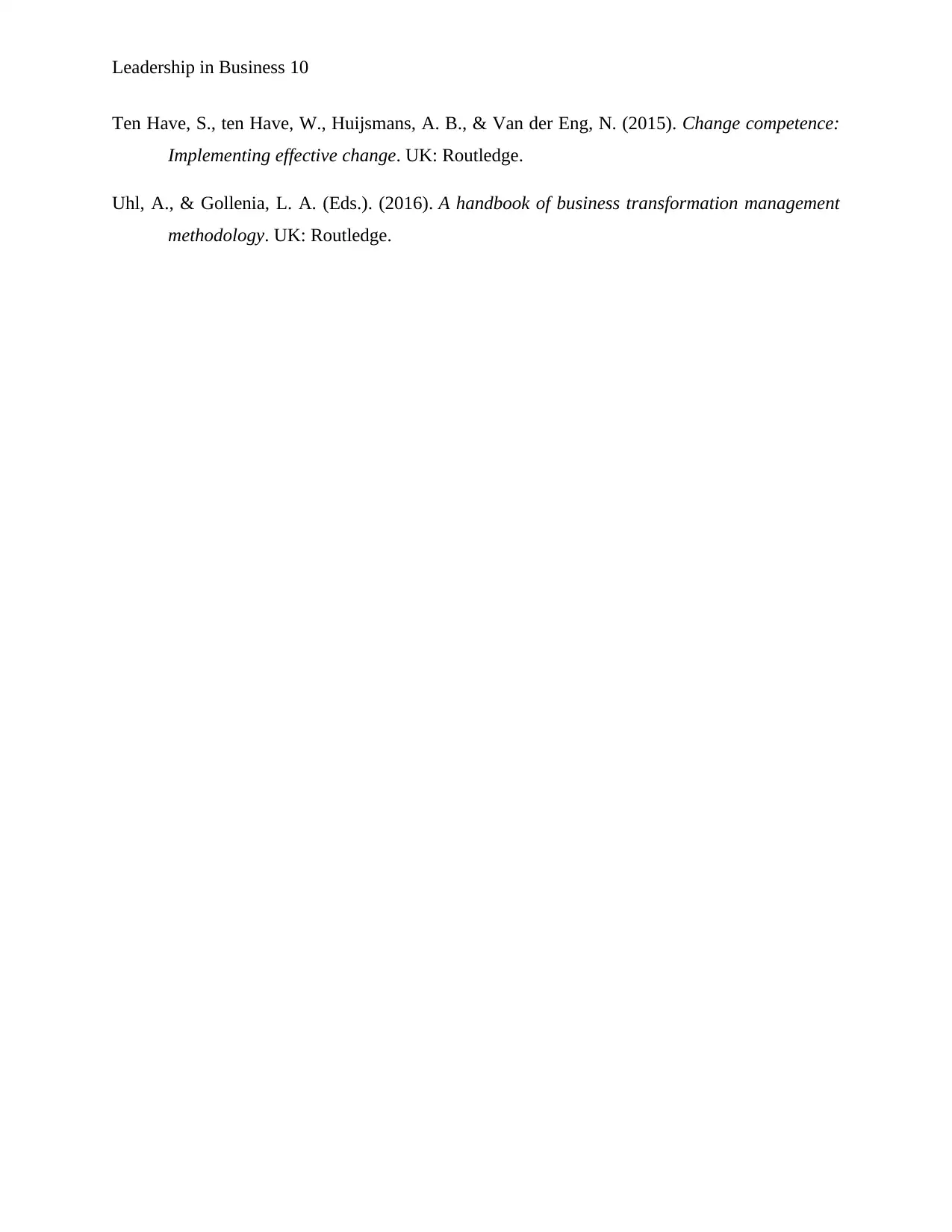
Leadership in Business 10
Ten Have, S., ten Have, W., Huijsmans, A. B., & Van der Eng, N. (2015). Change competence:
Implementing effective change. UK: Routledge.
Uhl, A., & Gollenia, L. A. (Eds.). (2016). A handbook of business transformation management
methodology. UK: Routledge.
Ten Have, S., ten Have, W., Huijsmans, A. B., & Van der Eng, N. (2015). Change competence:
Implementing effective change. UK: Routledge.
Uhl, A., & Gollenia, L. A. (Eds.). (2016). A handbook of business transformation management
methodology. UK: Routledge.
1 out of 11
Related Documents
Your All-in-One AI-Powered Toolkit for Academic Success.
+13062052269
info@desklib.com
Available 24*7 on WhatsApp / Email
![[object Object]](/_next/static/media/star-bottom.7253800d.svg)
Unlock your academic potential
Copyright © 2020–2025 A2Z Services. All Rights Reserved. Developed and managed by ZUCOL.





